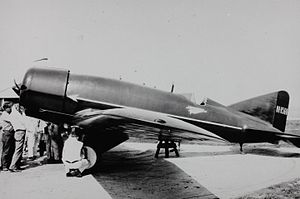Lockheed Explorer
| Lockheed Explorer | |
|---|---|
 The first Explorer with an experimental vertical stabilizer |
|
| Type: | |
| Design country: | |
| Manufacturer: | |
| First flight: |
June 1929 |
| Number of pieces: |
4th |
The Lockheed Explorer was originally planned for long-haul flights to explore the Antarctic by the US American manufacturer Lockheed Aircraft Company . The Explorer was the least successful of the early Lockheed developments.
history
development
The Explorer was designed by Jack Northrop in 1927, around the same time as the Vega . He combined the wooden fuselage of the Vega with a cantilevered wing in a low-wing design. The pilot's seat was in an open cockpit behind the wings.
The polar explorer Sir Hubert Wilkins carried out the first flight over the Arctic in a Lockheed Vega in April 1928 , which was followed by two research flights in the Antarctic in November 1928 with the same aircraft. In the meantime, Wilkins had considered using the Explorer, equipped with a central and two retractable outer support floats, for the Antarctic flights. He gave Lockheed a provisional contract to build a machine. But after he finally considered them unsuitable for this purpose, the further development at Lockheed was stopped. Wilkins then used the two-swimmer Vega instead. Lockheed chose the name Explorer in honor of Wilkins, who had made Lockheed known worldwide with his flights.
Afterwards, a non-stop flight between the USA and Japan was attempted with the Explorer , supported by businessman John Buffelen and members of the Tacoma Chamber of Commerce , who saw the planned flight as an advertisement for the region. Since neither the Vega nor the Air Express could be converted to carry the required amount of fuel, Jerry Vultee took up the work of the Explorer again as Northrop's successor as chief designer. The City of Tacoma was completed on June 18, 1929 and the first flight took place in the same month. The trans-Pacific flight took off from Pierce County Airport ( Washington ) on a special inclined ramp. The machine got out of control and had to be written off, only individual parts could be saved.
The second City of Tacoma , built as a replacement, was completed in September 1929 with the salvaged parts and the engine from the first machine. To increase the range, the landing gear could be blown off after take-off, after which the landing should take place on a skid. This machine crashed due to strong tail flutter on September 18, 1929 on its first flight and had to be written off as a total loss.
Lockheed was forced to build a third machine, whereby the name of Explorer 4 changed to Explorer 7 due to the numerous changes. A modified vertical tail unit, a new engine and, for the first time, a V-position of the wings were used. A two-month flight test was successful, all that remained was to prove the ability to take off with a full fuel charge. For this purpose, the machine was transferred to Muroc Dry Lake , where the aircraft crashed and burned out on May 24, 1930 during the first test flight with full tanks.
The second Explorer 7, completed in April 1930, had a slightly reduced tank capacity and was purchased by the Pure Oil Company, where it was named Blue Flash . Before long-haul flights could be started, the machine suffered an accident. After the repair at Lockheed, she performed on 9/10. November 1930 made the first non-stop flight from New York to the Canal Zone . Just eleven days after this flight, another accident almost completely destroyed the aircraft. Parts of it were brought back to the USA and the wing was assembled with an Orion 9E fuselage (NC12283) to form an Orion Explorer hybrid. On August 15, 1935, Wiley Post and Will Rogers died in this aircraft in a crash near the village of Walakpi, Alaska .
Built copies
The four built copies were all destroyed in crashes.
- Work no. 2: Explorer 4, aircraft registration NR856H
- Work no. 116: Explorer 4, aircraft registration NR856H (replacement for serial number 2)
- Work no. 147: Explorer 7, aircraft registration NR100W
- Work no. 148: Explorer 7, aircraft registration NR101W
Technical specifications
| Parameter | Data (1. Explorer 4) |
|---|---|
| crew | 1 |
| length | 8.38 m |
| span | 14.78 m |
| Wing area | 29 m² |
| Wing loading | 140.5 kg / m² |
| height | 2.49 m |
| Range | 8,850 km |
| Top speed | 265 km / h |
| Rate of climb | 366 m / min |
| Max. Altitude | 12,500 m |
| Empty mass | 1,395 kg |
| Max. Takeoff mass (normal) | 4,086 kg |
| Max. Takeoff mass (overload) | 5,481 kg |
| Engines | a Pratt & Whitney R-1340 with an output of 450 hp |
literature
- René J. Francillon: Lockheed Aircraft since 1913 . Putnam & Co., 2nd revised edition 1987, ISBN 0-85177-805-4 , pp. 91-95.
Web links
Individual evidence
- ↑ Michael O'Leary: By Vega to the Poles . In: Airplane Monthly May 2005, pp. 96-99.
- ↑ Photos of the crashed machine by Post and Rogers ( Memento from July 17, 2016 in the Internet Archive )